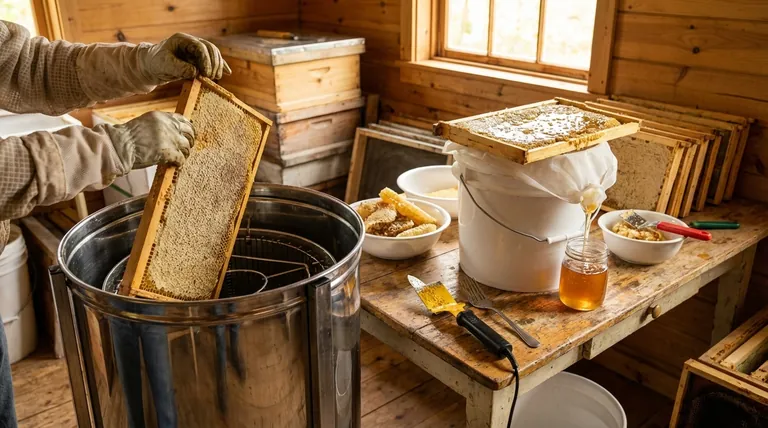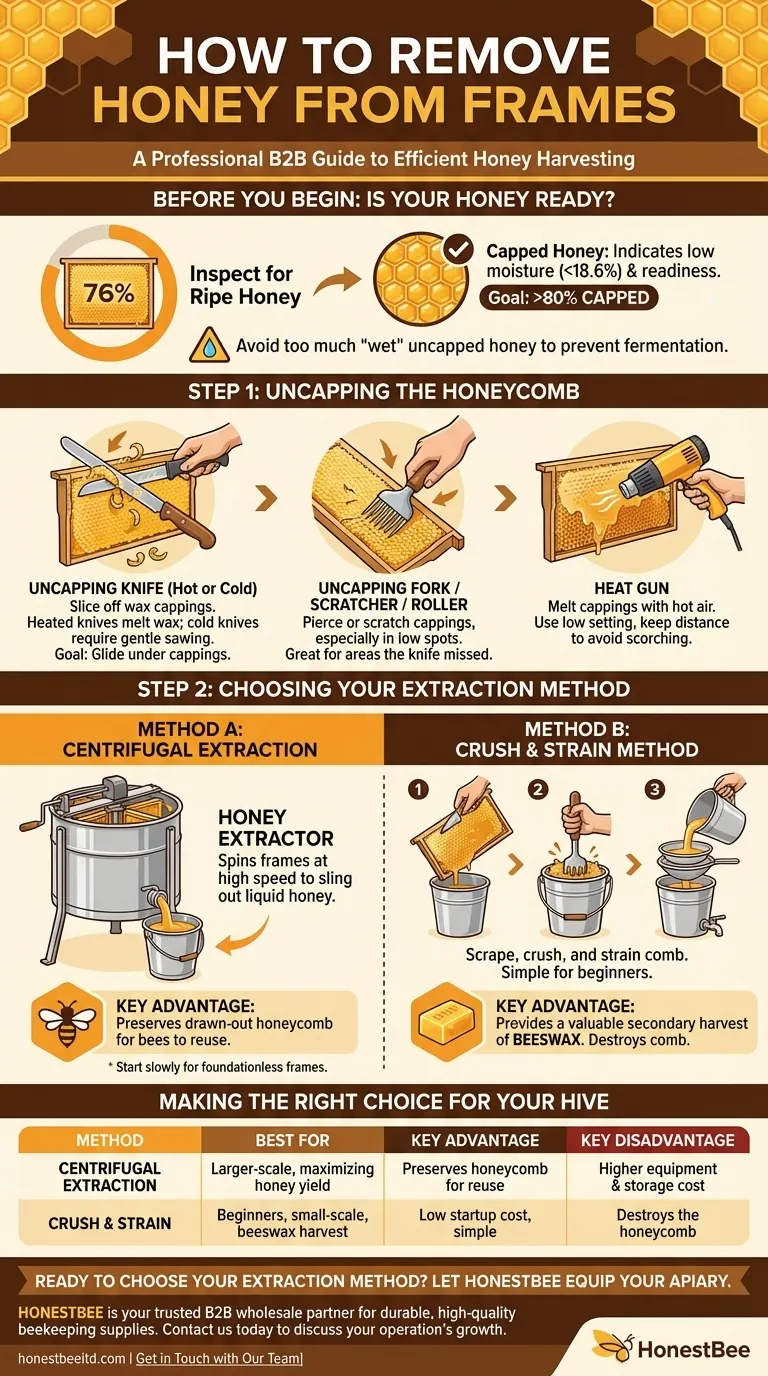To remove honey from frames, you must first uncap the wax-sealed honeycomb using a special knife, fork, or heat gun. Once the cells are open, you can either spin the frames in a centrifugal extractor to sling the honey out or use the "crush and strain" method, where you scrape the comb off the frame, crush it, and filter the honey.
The method you choose to extract honey is a critical decision that hinges on your goals. Centrifugal extraction is efficient and preserves the honeycomb for the bees, while the crush and strain method is simpler for beginners and yields valuable beeswax.

Before You Begin: Is Your Honey Ready?
The first and most critical step happens before you bring any tools near your frames. You must inspect the honey to ensure it is "ripe" and ready for harvest.
Look for Capped Honey
Honeybees cap cells with a layer of fresh beeswax only when the honey inside has been dehydrated to the proper moisture content (below 18.6%). This capping prevents fermentation and spoilage.
A frame that is ready for harvest should be at least 80% covered with this waxy, yellow-white coating. Harvesting frames with too much uncapped, "wet" honey can lead to a batch that ferments and spoils.
Step 1: Uncapping the Honeycomb
To get the honey out, you first have to remove the wax cappings. This process requires a delicate touch to avoid damaging the comb structure underneath, especially if you plan to reuse it.
Using an Uncapping Knife (Hot or Cold)
An uncapping knife is a long, sharp blade used to slice off the top layer of wax. Electric or heated knives melt through the wax, making the process smoother. Cold knives work as well but require a quick, gentle sawing motion.
The goal is to glide the knife just under the cappings, removing only a thin layer. Avoid applying too much pressure or cutting deep into the honey cells.
Using Forks, Scratchers, or Rollers
These tools are excellent for uncapping areas the knife may have missed, such as low spots on the comb. An uncapping fork or scratcher uses sharp tines to pierce and lift the cappings.
A spiked uncapping roller is a fast way to perforate the cappings across the frame, though it can be slightly messier than a knife.
Using a Heat Gun
You can also use a heat gun on its lowest setting to melt the cappings. Wave it quickly over the frame from a distance of about 10 inches. The wax will shrivel and melt in a second, exposing the honey. This requires care to avoid scorching the honey or the wooden frame.
Step 2: Choosing Your Extraction Method
Once uncapped, the honey is ready to be removed from the cells. The two primary methods cater to different scales of beekeeping and different goals.
Method A: Centrifugal Extraction
A honey extractor is a large drum that spins frames at high speed. Centrifugal force slings the liquid honey out of the cells, where it hits the wall of the drum and drains to the bottom.
This is the preferred method for most beekeepers because it preserves the drawn-out honeycomb. Returning empty, intact comb to the bees saves them an immense amount of energy and resources, allowing them to focus on making more honey.
If you use foundationless frames, you must take extra care. Start the extractor very slowly to allow some of the heavy honey to drain, making the comb lighter and less prone to breaking apart.
Method B: The Crush and Strain Method
This low-tech method is perfect for small-scale beekeepers or those with only a few hives. Simply scrape the entire honeycomb off the frame into a bucket.
Next, crush the comb with a masher or your hands to break open all the cells. Pour the resulting mixture of honey and wax into a sieve or filter system (like a bucket with a spigot and layered filters) and let gravity do the work. The honey will slowly drip through, leaving the beeswax behind.
Understanding the Trade-offs: Extraction vs. Crush and Strain
Neither method is universally "better"; they serve different purposes and come with distinct advantages and disadvantages.
Equipment Cost and Complexity
Centrifugal extractors are a significant financial investment and require space to operate and store. The crush and strain method, by contrast, requires only basic kitchen tools like buckets, filters, and a masher, making it extremely accessible for beginners.
Speed and Scale
For anyone with more than a few hives, centrifugal extraction is vastly faster and more efficient. Uncapping and spinning a dozen frames can be done in a fraction of the time it would take to crush and slowly strain the same amount.
Comb Preservation vs. Beeswax Harvest
This is the most important distinction. An extractor saves the comb, giving your bees a massive head start for the next season. The crush and strain method destroys the comb but provides a secondary harvest of clean beeswax, which has many valuable uses.
Making the Right Choice for Your Hive
To choose your path, consider your primary objective as a beekeeper.
- If your primary focus is maximizing honey production and long-term hive productivity: Invest in a centrifugal extractor to preserve your drawn comb.
- If your primary focus is simplicity, low startup cost, and harvesting beeswax: The crush and strain method is your ideal starting point.
- If you are working with delicate foundationless or top-bar frames: The crush and strain method is the safest option, though careful, slow-speed extraction is possible.
Ultimately, extracting honey is the rewarding culmination of a season of hard work, both yours and your bees'.
Summary Table:
| Method | Best For | Key Advantage | Key Disadvantage |
|---|---|---|---|
| Centrifugal Extraction | Larger-scale production, maximizing honey yield | Preserves honeycomb for bees to reuse | Higher equipment cost and storage needs |
| Crush & Strain | Beginners, small-scale beekeeping, beeswax harvest | Low startup cost, simple process | Destroys the honeycomb |
Ready to Choose Your Extraction Method? Let HONESTBEE Equip Your Apiary.
Whether you're a commercial apiary scaling up production with efficient centrifugal extractors or a distributor stocking up on essential uncapping tools and strainers for your customers, HONESTBEE is your trusted wholesale partner. We supply the durable, high-quality beekeeping supplies and equipment you need for a successful harvest.
Contact us today to discuss your needs and see how we can support your operation's growth.
Visual Guide

Related Products
- HONESTBEE 72 Frame Industrial Electric Honey Extractor for Beekeeping
- electric honey extractor honey centrifuge 3 frame honey extractor stainless steel honey frame extractor
- 2 Frame Stainless Steel Manual Honey Spinner Extractor for Beekeeping
- 40 Frame Commercial Electric Honey Extractor for Beekeeping
- Commercial Electric 12 Frame Honey Extractor Spinner Motorized Honey Extractor
People Also Ask
- What are the advantages of automatic honey extractors? Scale Your Apiary with Unmatched Efficiency
- How is honey harvested from Langstroth hives? A Guide to Efficient, Comb-Preserving Extraction
- What are the two common types of honey extractors? Choose the Right Extractor for Your Apiary
- How do automatic honey extractors function? Achieve High-Efficiency Honey Harvesting
- What is the energy consumption like for automatic honey extractors? Maximize Your Harvest Efficiency



















